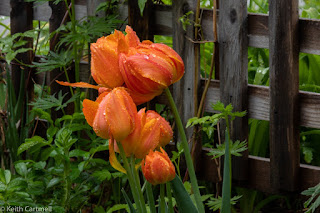Usually in photography the idea is for everything to be still. No movement. Photographers learn to hold the camera so it doesn't move. We brace our bodies or the camera against something. We wait for the subject to not move.
Except there are times you want movement. Light trails. Panning the camera as something moves across the field of view. The trick is to figure out what needs to stay still, what needs to move and by how much, and what shutter speed to select to get the effect you want. Consider that most cameras can have the shutter open for as long as the battery lasts, to 1/4000 of a second, so there's lots of choice.
I've had this thought of the flowers moving in the wind to produce a blur of colour, and yesterday looked like a good day to try, what with one thing and another.
Here's what it looks like when everything is still.
1.
And now with varying amounts of movement. Same shutter speed, just different amounts of wind.
2.
3.
4.
5.
6.
Normally I don't discuss settings, since for most shots there are many combinations of settings that will produce acceptable results. But here settings are key. ISO 100, f32, 2 seconds, 200 mm lens with an ND filter dialled up to about the maximum without banding.
Here's an earlier example as I was setting up. I am totally taken with these orange tulips.
7.
8.
The rest of the morning was just more flowers wet with raindrops in lovely cloudy light. You know, like so many others. But the purple irises are new, here's a couple of them. (Hi Susi!)
9.
10.
Of the Day
Michelle
Curtis and Celina
Flowers
Driftwood















Oh we like purple - purple good - purple saturated.
ReplyDeleteYears ago I did a series of trees where the movement was introduced in the darkroom. These photos remind of that. Of the 6, #5 is my preference as I like the abstraction that occurs and yet I know it is a flower. I am not sure though of your choice in background. Given how dominant the lattice is in the image, I think it needs to be lighter and in focus or darker and more out of focus. If the latter is chosen then the brightness of the flowers would increase the contrast in motion. As you continue with this experiment you may want to play with different background treatments to see which treatment works (compliment or contrast) for you. I was listening to a seminar over the weekend about how depth of expression is in part a function of doing a deep dive into a particular area. I like your new dive dive into the flower pool, and I look forward to seeing the evolution of this idea. Cheers, Sean
Now blogger even eats my own comments. I replied to Sean and it disappeared.
ReplyDeleteI have to admit when I was taking the shots, the background was the least of my concerns. I only wanted it in focus, and trying to capture the flowers waving in the wind. The shape of the garden limits the choices of background. I'll have another go with the peonies once they are in bloom. More choices there.